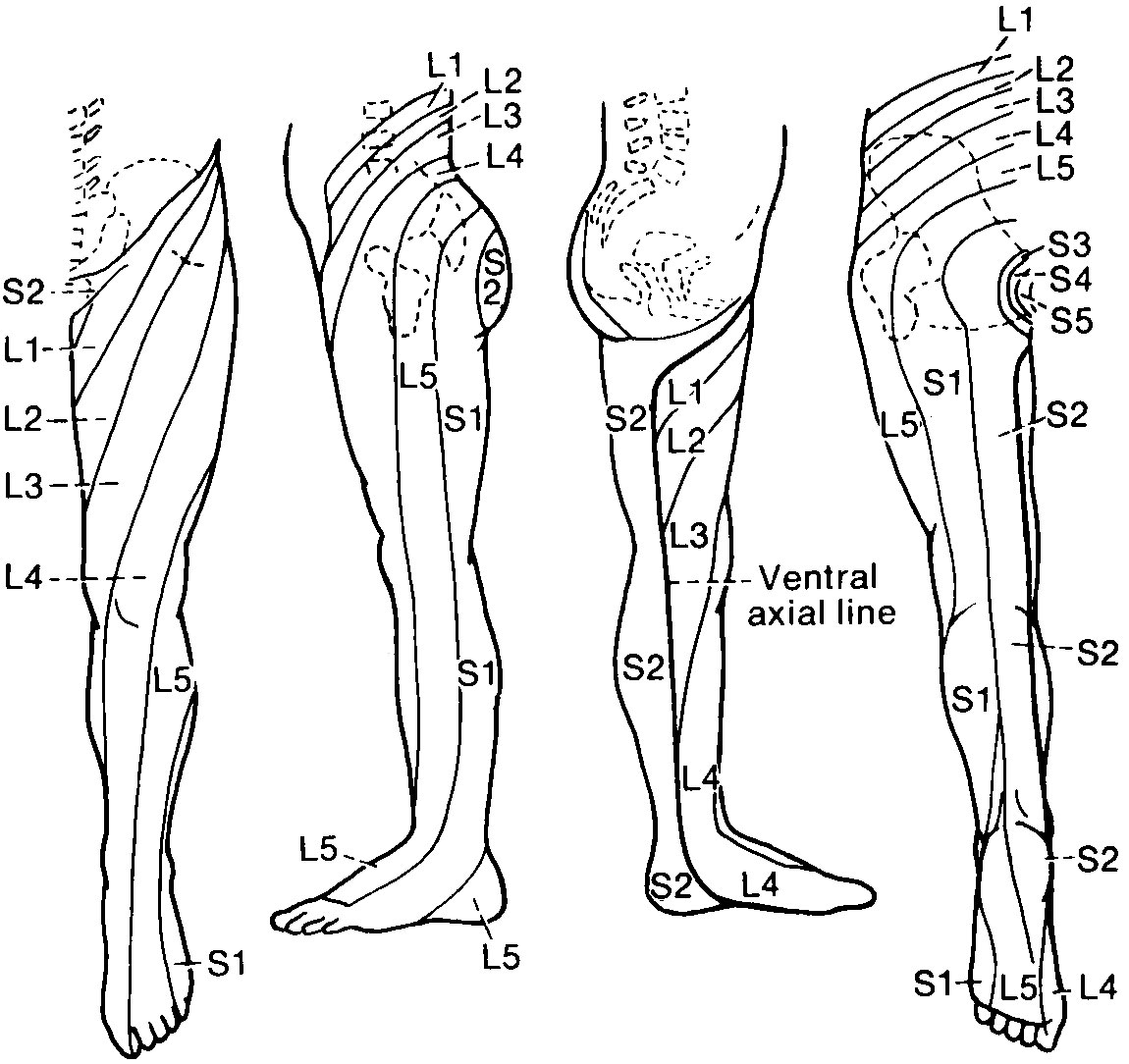
21 Aug Understanding Sciatica
 What is Sciatica?
What is Sciatica?
Sciatica is not a condition as such, but a symptom which can be caused by numerous conditions. The common sciatica symptoms involve pain that starts in the back and radiates down one (or both) of the legs. It is quite a common complaint and sciatica pain is caused by pressure on the sciatic nerve which runs down into the leg. The medical term is acute nerve root compression or radiculopathy.
The cause of pressure can be varied from a slipped disc (also known as a herniated or prolapsed disc), disc degeneration to muscle tension (Piriformis syndrome) or something less common such as a tumors, bony growths (stenosis) and infections.
A prolapsed disc or slipped disc as it is sometimes known is not simply a disc that has ‘slipped’ out of place. Intervertebral discs separate the bones of the spine (or vertebrae) and their function is to act as shock absorbers or cushioning for the spine and allow movement.
They quite happily allow flexion and extension (bending forwards and backwards), lateral flexion (sideways movement) and twisting. However a combination of the two can put excess stress on the spine and damage the discs. This is particularly common in people who may lift heavy objects and twist with them for example unloading heavy boxes off the back of a lorry.
The intervertebral discs are filled with a gelantinous substance in the middle called nucleus pulposus and when a disc prolapses this jelly-like centre squeezes out and puts pressure on the spinal cord compressing the nerve routes and causing pain.
Depending on where the sciatic nerve is pinched will determine where you feel the pain which can radiate to the front of the knee or right down the back of the leg to the foot. The L5-S1 disc is the disc most commonly damaged and the L4-L5 disc the next most commonly damaged. On the illustration below, L4 and L5 are the bottom two Lumbar vertebrae at the base of the spine. S1 is the top of the Sacrum.

Sciatica Symptoms
- Acute low back pain (not always present, especially in piriformis syndrome)
- Pain radiating down the leg. This pain may be sharp and accompanied by pins and needles and / or numbness
- Sciatica pain is often triggered by a minor movement such bending over to pick something up
- Pain may be worse by sitting, lifting, coughing or sneezing
- Pain is usually relieved by lying down, often on one side
- Pain is often better in the morning after a nights rest
- There may be muscle spasm in the lower back
- Tenderness in the lower back when pressing in
- Pain on the straight leg raise test which is not apparent when just stretching the hamstring only
Causes of Sciatica
Lumbar herniated disc
A herniated disc occurs when the soft inner core of the disc (nucleus pulposus) leaks out, or herniates, through the fibrous outer core (annulus) of the disc and irritates the contiguous nerve root as it exits the spine. In general, it is thought that a sudden twisting motion or injury can lead to an eventual disc herniation and sciatica. However, most discs weaken over time due to repetitive stress, eventually resulting in herniation. A herniated disc is sometimes referred to as a slipped disc, ruptured disc, bulging disc, protruding disc, or a pinched nerve, and sciatica is the most common symptom of a lumbar herniated disc.
Lumbar spinal stenosis
This condition commonly causes sciatica due to a narrowing of the spinal canal. Spinal stenosis. Lumbar spinal stenosis is related to natural aging in the spine and is relatively common in adults over age 60. The condition typically results from a combination of one or more of the following: enlarged facet joints, overgrowth of soft tissue, and a bulging disc placing pressure on the nerve roots as they exit the spine, causing sciatica pain.
Degenerative disc disease
While disc degeneration is a natural process that occurs with aging, for some people one or more degenerated discs in the lower back can also irritate a nerve root and cause sciatica. Degenerative disc disease is diagnosed when a weakened disc results in excessive micro-motion at that spinal level, and inflammatory proteins from inside the disc become exposed and irritate the area (including the nerve roots). This is truly not a disease despite its name, it is part of the natural aging process.
Isthmic spondylolisthesis
This condition occurs when a small stress fracture allows one vertebral body to slip forward on another vertebral body (e.g. the L5 vertebra slips over the S1 vertebra). With a combination of disc space collapse, the fracture, and the vertebral body slipping forward, the nerve can get pinched as it exits the spine and cause sciatica.
Piriformis syndrome
The sciatic nerve can also get irritated as it runs under the piriformis muscle in the rear. If the piriformis muscle irritates or pinches a nerve root that comprises the sciatic nerve, it can cause sciatica-type pain. This is not a true radiculopathy (the clinical definition of sciatica), but the leg pain can feel the same as sciatica caused by a nerve irritation.
Sacroiliac joint dysfunction
Irritation of the sacroiliac joint – located at the bottom of the spine – can also irritate the L5 nerve, which lies on top of the sacroiliac joint, causing sciatica-type pain. The leg pain can feel the same as sciatica caused by a nerve irritation.
Pregnancy
The changes that the body goes through during pregnancy, including weight gain, a shift on one’s center of gravity, and hormonal changes, can cause sciatica during pregnancy.
Scar Tissue
If scar tissue compresses the nerve root, it can cause sciatica.
Muscle Strain
In some cases, inflammation related to a muscle strain can put pressure on a nerve root and cause sciatica.
Spinal Tumor
In rare cases, a spinal tumor can impinge on a nerve root in the lower back and cause sciatica symptoms.
Infection
While rare, an infection that occurs in the low back can affect the nerve root and cause sciatica.
It is important to know the underlying clinical diagnosis of the cause of sciatica, as treatments will often differ depending on the cause.
Sciatica Treatment
For severe or ongoing flare-ups of sciatic nerve pain, the condition may need to be treated so that it does not get worse over time.
- For most, readily available nonsurgical remedies and regular exercise will go a long way to relieving their pain.
- For others, when the pain is severe or does not get better on its own, a more structured treatment approach, and possibly surgery, may offer the best approach to finding pain relief and preventing or minimizing future flare-ups of sciatica.
Non-Surgical Treatment for Sciatica
Non-surgical sciatica treatments encompass a broad range of options, with the goal of relieving pain caused by compressed nerve roots. One or some combination of the treatments below are usually recommended in conjunction with a specific exercise program.
Heat/Ice
For acute sciatic pain, heat and/or ice packs are readily available and can help alleviate the leg pain, especially in the initial phase. Usually ice or heat is applied for approximately 20 minutes, and repeated every two hours. Most people use ice first, but some people find more relief with heat. The two may be alternated.
Sciatica Pain Medications
Over-the-counter or prescription medications may also be helpful in relieving sciatica. Non-steroidal anti-inflammatory drugs (such as ibuprofen, naproxen, or COX-2 inhibitors), or oral steroids can be helpful in reducing the inflammation that is usually a contributing factor in causing sciatica pain.
Epidural Steroid Injections for Sciatica
If the sciatica pain is severe, an epidural steroid injection can be performed to reduce the inflammation. An epidural injection is different from oral medications because it injects steroids directly to the painful area around the sciatic nerve to help decrease the inflammation that may be causing the pain. While the effects tend to be temporary (providing pain relief for as little as one week up to a year), and it does not work for everyone, an epidural steroid injection can be effective in providing relief from an acute episode of sciatic pain. Importantly, it can provide sufficient relief to allow a patient to progress with a conditioning and exercise program.
Chiropractic/Manual Manipulation
Spinal adjustments and manual manipulation performed by appropriately trained health professionals (such as chiropractors, osteopathic physicians, physical therapists) are focused on providing better spinal column alignment, which in turn should help to address a number of underlying conditions that can cause sciatic nerve pain. Manual manipulation done to address the right indications by appropriately trained health professionals can create a better healing environment and should not be painful.
Acupuncture
The practice is centered on the philosophy of achieving or maintaining well being through the open flow of energy via specific pathways in the body. Hair-thin needles (that are usually not felt) are inserted into the skin near the area of pain. Acupuncture has been approved by the U.S. FDA as a treatment for back pain, and the National Institutes of Health recognized acupuncture as effective in relieving back pain, including sciatica.
Massage Therapy
Certain forms of massage therapy have been shown to have a number of benefits for back pain, including increased blood circulation, muscle relaxation, and release of endorphins (the body’s natural pain relievers).
For most people, the good news is that sciatica usually will get better on its own, and the healing process for most will only take a few days or weeks. Overall, the vast majority of episodes of sciatica pain heal within a six to twelve week time span. Following initial pain relief, a program of sciatica physical therapy and exercise should usually be pursued in order to alleviate pain and prevent or minimize any ongoing sciatic pain.
There are a number of types of non-surgical spine care professionals who specialize in treating sciatica symptoms, including chiropractors, physiatrists (physical medicine and rehabilitation specialists), pain medicine specialists, and physical therapists, all of whom have specialized training to provide pain relief and to help prevent future recurrences of sciatica. It is always advisable to have a qualified medical professional oversee any type of sciatica treatment.




Sorry, the comment form is closed at this time.